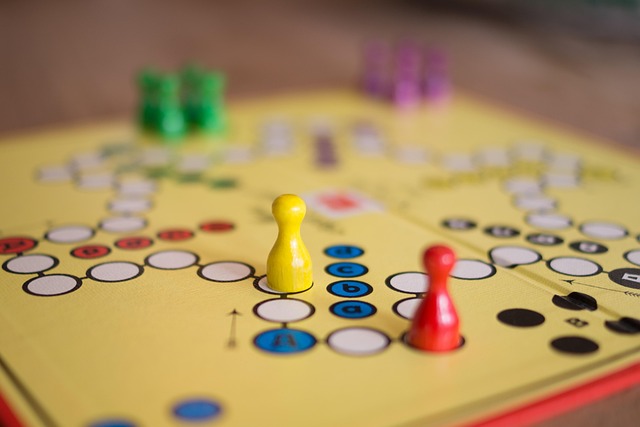Defining game theme and objective is crucial for an immersive experience. Board design considers audience, complexity, and player count, with strategic placement of elements. Engaging gameplay mechanics drive interaction and progression, blending fun with learning opportunities. Visually stunning components create immersive worlds, fostering exploration and debate. Balancing strategy and adaptability ensures accessibility and appeal to diverse players. Interactive presentations and online resources optimize the gaming experience.
Designing a captivating game board is an art that combines creativity with strategic thinking. This comprehensive guide will walk you through the essential steps to crafting your own unique game experience. From defining a compelling theme and objective to creating engaging gameplay mechanics and visually stunning components, each element contributes to player immersion. Learn how to balance design with playability testing to ensure a well-oiled gaming mechanism. Discover tips for creating a memorable game board that will enthrall players again and again.
- Define Game Theme and Objective
- Determine Board Layout and Size
- Create Engaging Gameplay Mechanics
- Design Visually Appealing Components
- Balance and Test Playability
Define Game Theme and Objective

Defining your game’s theme and objective is the first step in creating an engaging experience. The theme sets the stage, establishing the world and context for players to explore. It can be inspired by real-world settings like historical eras, fantastical realms, or even modern-day scenarios. For instance, a game themed around public speaking tips could transport players into a futuristic conference hall where they must navigate through speech challenges to progress. This theme not only piques interest but also provides a clear direction for gameplay mechanics and storytelling.
The objective is the driving force behind every move players make. It could be reaching a specific destination, collecting items, or defeating enemies. For example, in a personalized education-focused game, the objective might be to earn badges by mastering various subjects, each represented as unique levels or quests. By defining these aspects early on, designers can ensure that all subsequent choices and features align with the core concept, making the final product more cohesive and captivating for players. Consider giving us a call at creative writing prompts for further insights tailored to your unique game design needs.
Determine Board Layout and Size

When designing a game board, one of the first steps is to determine its layout and size. The physical dimensions of your board should align with the intended audience and the complexity of the game. A larger board might be suitable for more intricate games that require players to navigate a vast space, while smaller boards are often used for simpler games or those designed for portability. Consider the number of players you expect to engage in the game; this will influence both the layout and size.
The layout should cater to the flow of gameplay, ensuring that all elements, from starting points to goal areas, are strategically placed. Incorporate elements like paths, spaces, or zones that facilitate movement and decision-making. For instance, a strategic placement of special zones could enhance gamification strategies, while a well-designed path encourages players to explore different aspects of the digital storytelling within your game. Remember, the board is not just a playing surface; it’s a visual representation of the experience you’re crafting. Visit our website at find us at philosophy debates for more insights into creating immersive and engaging games.
Create Engaging Gameplay Mechanics

Designing engaging gameplay mechanics is a core aspect of crafting an immersive game experience. To achieve this, designers should focus on creating rules and systems that foster strategic thinking, problem-solving, and interaction among players. Incorporate elements like resource management, decision-making points, and dynamic challenges to keep players invested throughout the level progression. For instance, incorporating strategies inspired from real-world scenarios, such as economic models or historical events, can add depth and educational value. By seamlessly integrating these mechanics, you can transform the game into a platform for learning digital citizenship lessons or even art history insights.
Furthermore, consider how gameplay can encourage collaboration, competition, and social interaction. This could involve designing multiplayer modes that promote teamwork or friendly rivalry, fostering a sense of community within the game. Remember, the best gameplay mechanics not only captivate players but also offer opportunities for personal growth and exploration, ensuring an enjoyable and meaningful experience. For more insights on game design and to learn how to incorporate unique educational elements, visit us at phylosopy debates anytime.
Design Visually Appealing Components

Designing visually appealing components is an art that captivates players and enhances their experience in any game. The aesthetics of the board, cards, and other elements can significantly impact engagement, making it a crucial aspect to consider. Incorporate vibrant colors, intricate patterns, and themes that align with the game’s concept to create an immersive environment. For instance, if your game revolves around nature, use organic shapes and earthy tones to transport players into a lush forest.
A well-designed board should also tell a story, inviting players to explore and interact. Consider using symbolism and subtle hints on the components to spark phylosopy debates among players. This strategy not only adds depth but also encourages critical thinking. Furthermore, by adapting learning paths to suit different skill levels, you can cater to a broader audience, making your game accessible and enjoyable for all. Integrating these elements seamlessly will make your board game an appealing choice for those seeking both entertainment and intellectual stimulation, even encouraging STEM curriculum integration through creative play. Find us at study habits improvement to discover more insights into crafting captivating game experiences.
Balance and Test Playability

Achieving balance in your game board design is paramount to ensuring an engaging and enjoyable experience for all players. This involves meticulously considering the distribution of resources, challenges, and rewards throughout the game. A well-balanced game encourages strategic thinking while still allowing room for luck and adaptability; it’s this blend that fosters interaction and keeps players invested. Testing playability is equally crucial. Gather a diverse group of testers to play your game, observe their experiences, and take note of any bottlenecks or unclear rules. This iterative process enables you to refine the gameplay flow, ensuring that the game appeals to a wide audience.
By creating an interactive presentation that allows for learning style assessments, you can further personalize the education aspect within your game. For instance, consider incorporating various media types—visuals, audio, and interactive elements—to cater to different learning preferences. This not only enhances engagement but also reinforces concepts more effectively. As you develop your game, keep in mind resources like test preparation techniques available online for additional insights into player behavior and how to optimize the overall experience.
Designing a captivating game board involves merging creative vision with strategic thinking. By defining a clear theme and objective, establishing an intuitive layout, crafting engaging mechanics, and creating visually stunning components, you lay the foundation for an immersive gaming experience. Balance is key; testing playability ensures adjustments can be made to refine the game, making it enjoyable for all players. Embrace these steps, let your creativity flow, and watch your unique board game come to life.

Leave a Reply